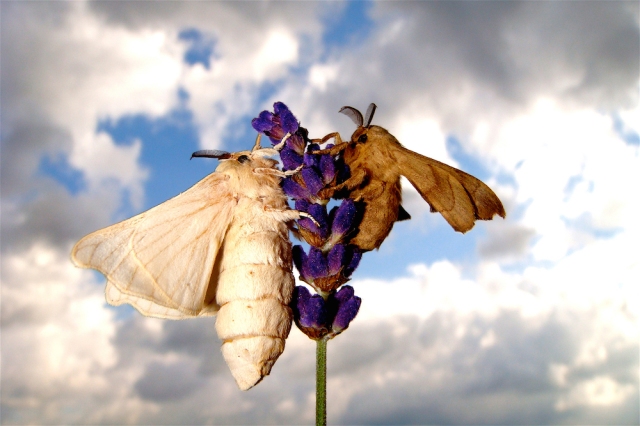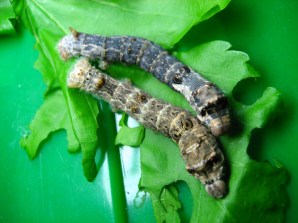
Female moths of the Bombyx mori (left) and Bombyx mandarina (right).
Credit: Markus Knaden, Max Planck Institute for Chemical Ecology.
The Bombyx mori moth is well-known as producer of the silk cultivated in China for thousands of years whose technology — including the breeding of the caterpillars (silkworms) and the source of their preferred food, white mulberry trees — spread across Eurasia during the period of the Silk Road. Both moth and mulberry were native to China and the former was domesticated, so enabling silk to be efficiently produced in a cottage industry. But it was only when I came to be interviewed for a BBC Radio 4 programme on the moth that I understood fully what domestication means for the moth itself.
The wild cousin of the Bombyx mori, the Bombyx mandarina lives for several weeks. After breeding, the female lays hundreds of tiny eggs on the white mulberry (Morus alba). The moths die but their eggs soon hatch. The caterpillars/larva — silkworms — move around the tree to find new leaves to satisfy their voracious appetites. Inevitably many are eaten, die of disease or fail to find sufficient food. Those that survive shed their skins several times and develop new ones to accommodate their rapidly expanding bodies, each new stage called an instar.
The caterpillars of the Bombyx mandarina (left) and Bombyx mori (right) showing the lack of skin pigment in the domesticated breed.
Once fully grown, the silkworm finds a suitable place where it can spin a cocoon around itself and enter its pupa stage. Often it will remain there over the winter, transforming into a moth as the spring set in and the new buds formed on the mulberries. When ready, it breaks out of the cocoon, pumping fluid into its wrinkly wings to make then expand and, when able, fly off to eat and find a mate.
After so many years of being cultivated, the domesticated Bombyx mori — moth, silkworm and pupae — might be larger than its wild cousin, but it is rather feeble in comparison. It has lost its skin pigments — a state called leucistic — as it has no need of camouflage being protected from predators by its human rearers. Used to being brought food, the caterpillar/silkworm does not travel far and might die if it is not regularly brought new leaves. It digests more efficiently and grows more quickly but, like its wild cousin, after several instars it spins a cocoon — also larger and whiter.

Comparison of the cocoons from the domesticated and wild moths.
Most of the domesticated pupae do not develop into moths as they are killed before they can break the precious cocoons. The cocoons are usually boiled, as this enables the 300-900 metres of silk to be unwound. The moths that do hatch have a very short life. Unable to fly or eat, they are placed together for mating. The males might get the chance to mate two or three times but they have then used up their usefulness and die. The females live to lay their eggs, like their wild ancestors, but unable to eat or move from their confined space.
Further images and information:
On Bombyx mandarina in Spain.
On Bombyx mandarina in Japan.
On the bombyx mori lifecycle.
On its lack of smell compared to its wild cousin
And a blog post on modern domestic sericulture and its challenges today.



Pingback: Orchard Moon – Is silk sustainable and cruelty free?